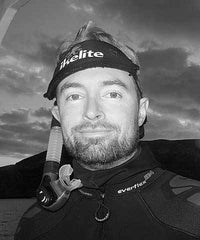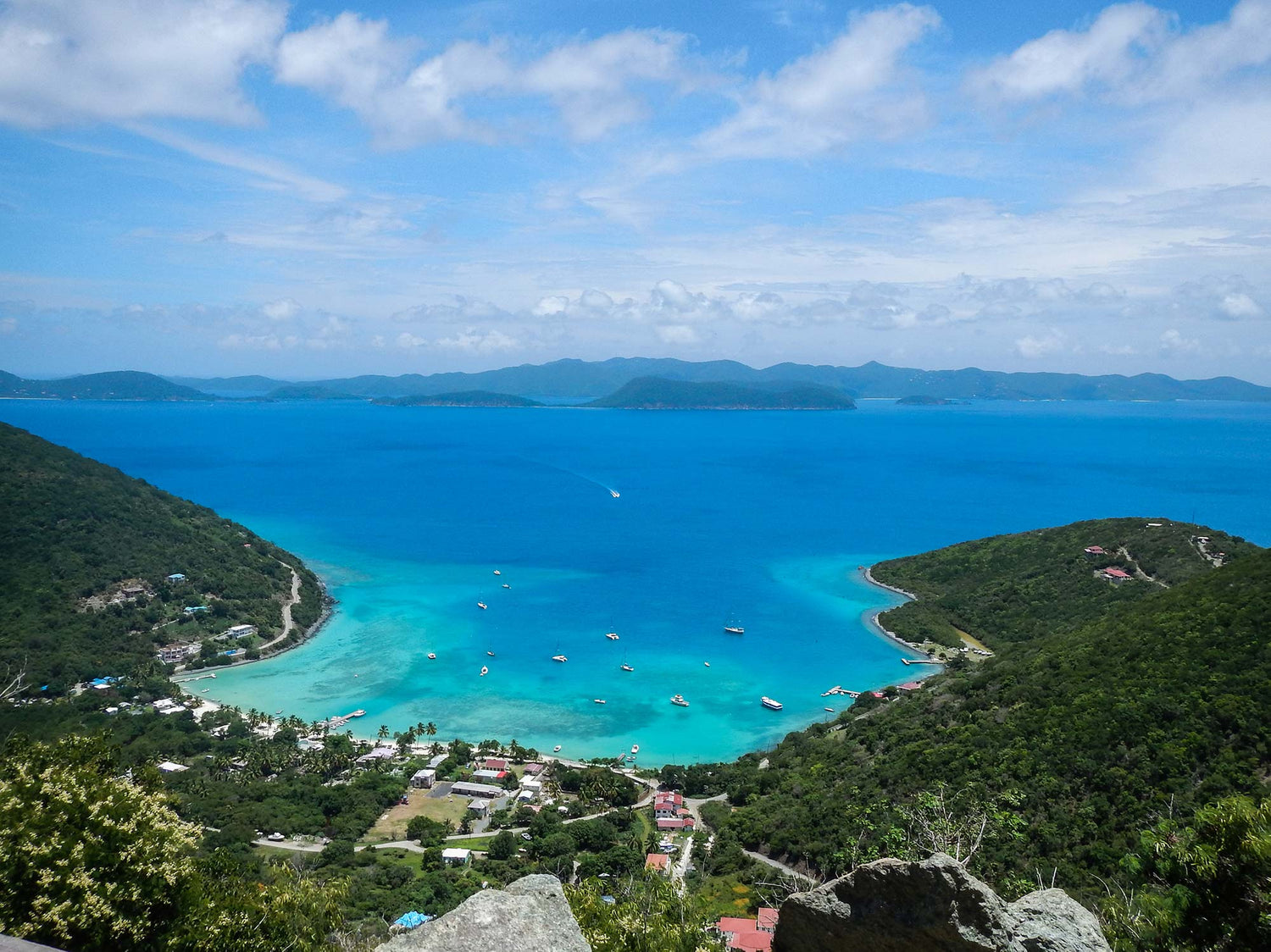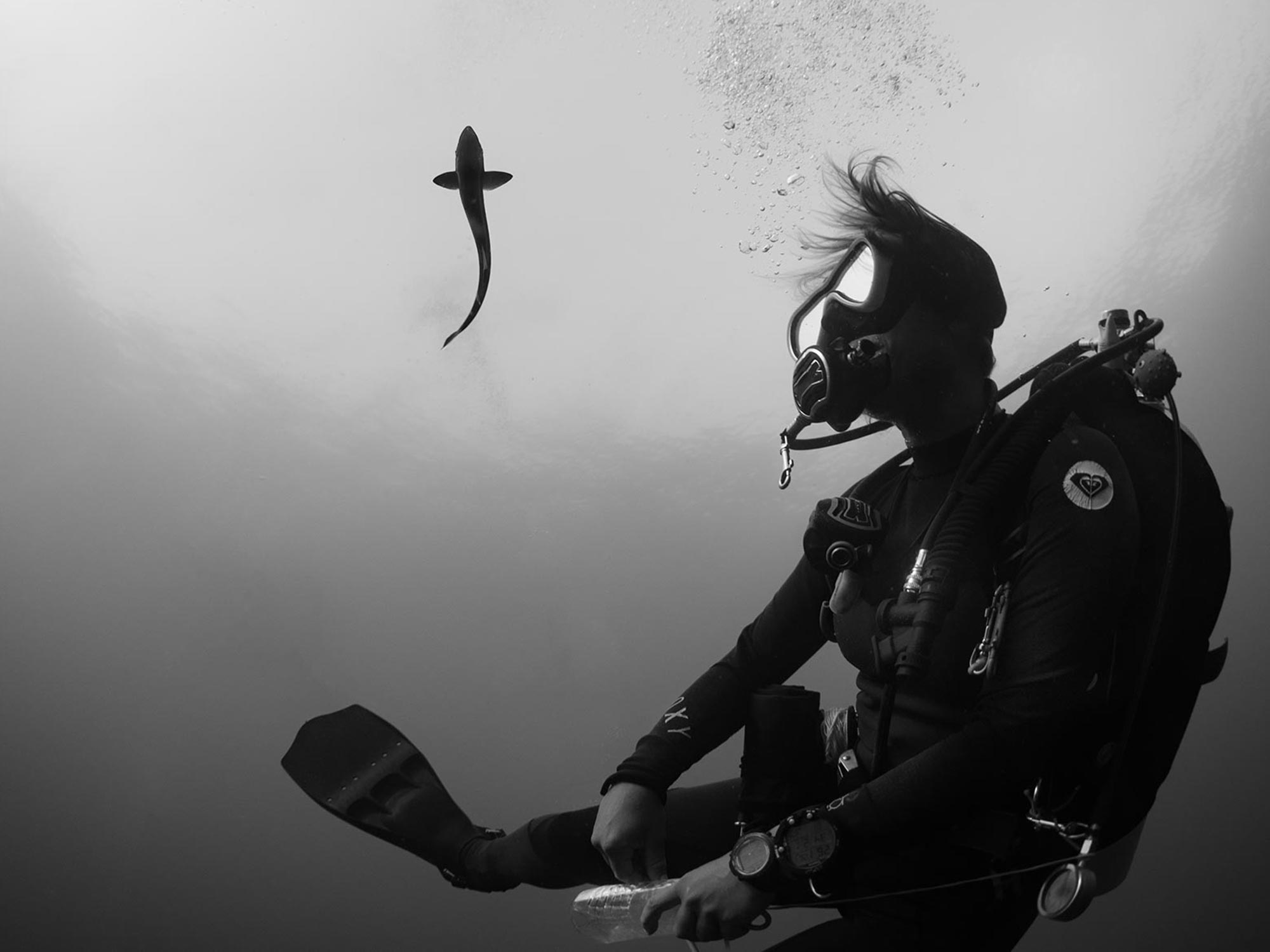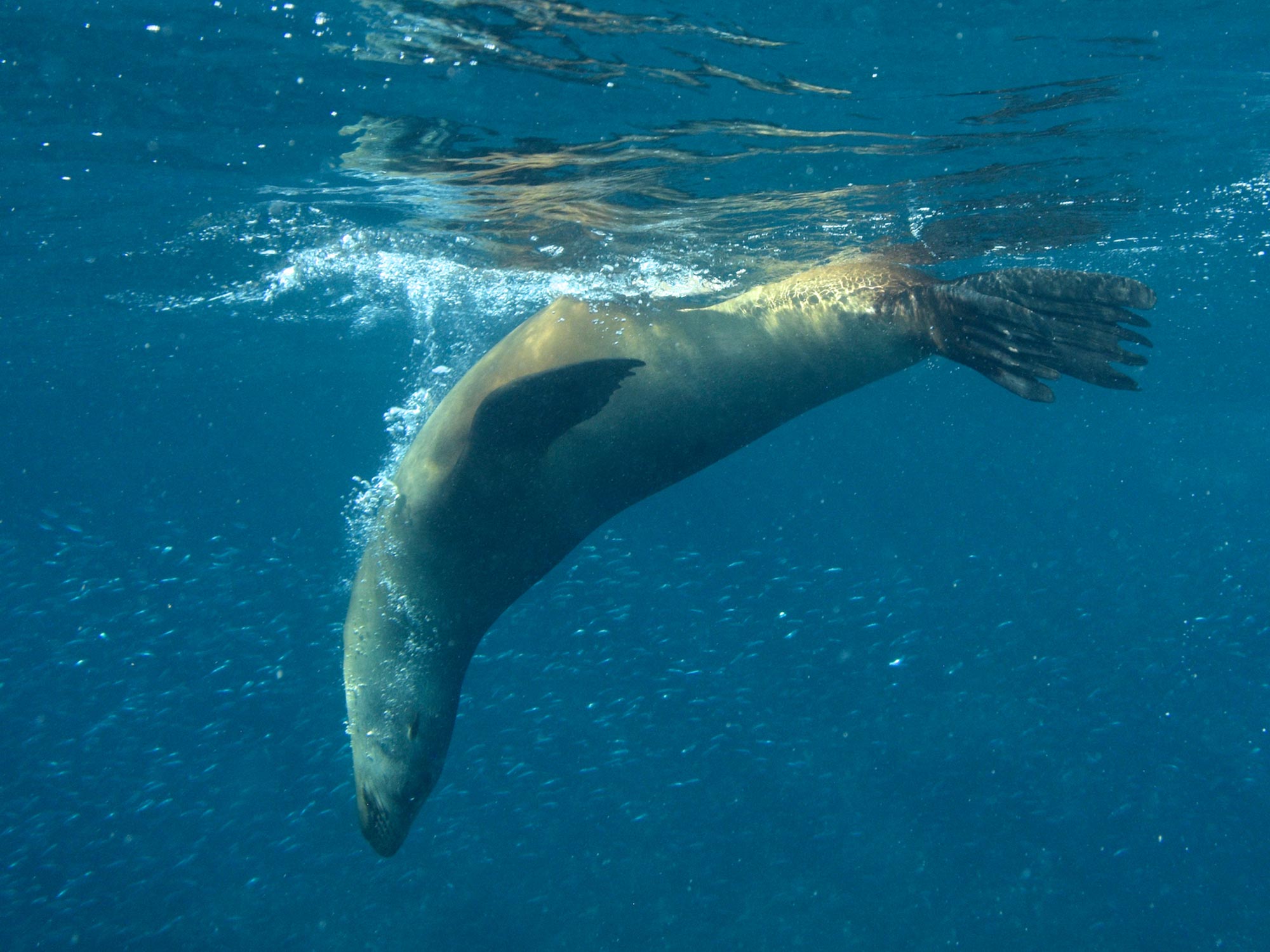By Bryant Turffs
This past January, I traveled to the British Virgin Islands (BVI) on a family sailing trip long delayed by Covid-19. It was an exciting opportunity for me to revisit a place where I had previously worked as a dive instructor and boat captain. The Virgin islands, both British and US, combine stunning tropical mountainous vistas above water with excellent diving opportunities below. The BVI’s require a passport and slightly more complicated travel for Americans, but offer the chance to hop between the territories numerous islands and enjoy a diversity of experiences. The purpose of this trip was not diving and we missed out on some of the most famous BVI dive sites, but we still squeezed in a couple tanks and quite a bit of snorkeling.

The Bight, a popular anchorage at Norman Island. © 2022 Bryant Turffs
Diving in the BVI

A black and white conversion of our dive guide searching for subjects. ISO 800 · 10mm · f/11· 1/250th. © 2022 Bryant Turffs
The BVI is home to a plethora of great dive sites for all tastes. Some of the most famous sites are wrecks, like the historic RMS Rhone, but there are also a great many natural sites featuring rock formations, coral, and abundant marine life. Accessing dive sites in the BVI can be a challenge as the territory is quite large and there are sites scattered across the islands. Fortunately, there are a many great local operators that offer at least three different ways to dive.
Conventional. Dive shops on the territory’s main Islands, Tortola, Virgin Gorda, and Jost Van Dyke, offer traditional daily boat trips. The upshot to these conventional trips is that they are convenient for those staying in a hotel on land, but the downside is that each shop tends to visit only the sites in its vicinity. Thus, sampling all the BVI’s have to offer would still require visiting multiple islands.
Private Charter Vessel. The best way to experience the BVI is to charter a private vessel and sail (or motor) throughout the territory, which allows you to create your own experiences and visit new anchorages each day. Charter companies offer scuba tanks as an add on, which can be refilled at any dive center in the territory. This more adventurous option requires more planning and handling of logistics, but might be the best way to see all that the islands have to offer.
Rendezvous Diving. A third option, if you are chartering a vessel, but do not wish to handle your own dive logistics is rendezvous diving. Most dive operators offer to pick you up from your charter vessel, take you diving, and drop you off afterward. As we were staying on board a chartered sailing catamaran with the extended family, and as most of the party did not want to join us diving, this is the option we chose.

Shark-Planeo - Jessica surveys one of three unique artificial wrecks on this site. This image was shot with ambient light in about 40 feet of water and white balanced with computer software. ISO 800 · 10mm · f/11 · 1/250th. © 2022 Bryant Turffs
We booked two days of diving, the first in an area known as the Dog Islands where we visited two sites called Chimneys and Shark-Planeo. The first features great rock formations and swim throughs named for a mountain climbing technique and on this dive we saw an octopus and many reef fishes. The second featured some unique artificial wrecks / art pieces, and a nice coral reef. On our second day of diving we hoped to dive the north shore of Jost Van Dyke, known for its large pelagic marine life, but weather limited us to a couple nice reef dives on Great Thatch Island instead. A great advantage of staying on board our charter catamaran was that it allowed us to snorkel in almost every anchorage we visited, in addition to our diving. While snorkeling we encountered foraging southern stingrays in shallow sandy bays, abundant reef fishes, and historic anchors!

An anchor from an unknown ship, Great Harbor, Peter Island. Photographed while free diving at about 30 feet. White balanced using computer software. ISO 400 · 10mm · f/11 · 1/250th. © 2022 Bryant Turffs
My BVI Images
For this sailing trip, I was limited on packing space and chose to carry my Ikelite 200DL housing for the Canon 7D Mark II and the Compact 8” Dome Port for my Tokina fisheye lens. Unfortunately, I had to leave my DS 160 strobes behind and make the most of shooting ambient light images. Carrying the housing and compact dome port alone was a very streamlined experience, both on the plane where it fit in a carry-on backpack, and underwater. Because the light spectrum is quickly absorbed underwater, strobes are crucial to creating vibrant color. There are, however, artistic techniques and technological tricks that can help you get the most out of ambient light underwater images. These include staying shallow, shooting silhouettes, and black & white conversion. Focusing on these techniques was a good creative challenge for me and helped break me out of my normal image making thought processes. Practicing these techniques can benefit your images, whether or not you have made the investment in strobes.
Staying Shallow
On our daily snorkels, I was limited to shooting at shallow depths by my breath hold capacity. During these forays, I shot a variety of marine life subjects including the featured stingray. While making these images I tried to stay conscious of the sun’s position and to keep it at my back. Without strobes for fill light, shooting towards the sun in these conditions would create bright overexposed areas, and deep shadows without detail. By keeping the sun behind me, I was able to reveal the most detail and color. At these shallow depths, typically less than 10 feet (3 meters), there is still good light penetration and therefore the images contain decent color. I still chose to white balance these images in Adobe Lightroom using the eyedropper tool and even made adjustments in the hue, saturation, and luminance (HSL) panel to get the most out of them.

Southern Stingray - Photographed while snorkeling in about 10 feet of water. White balanced using computer software. ISO 800 · 10mm · f/11 · 1/200th. © 2022 Bryant Turffs
Shooting Silhouettes
At depths of 40 feet (13 meters) or more the water column has absorbed most of the color spectrum and ambient light images become blue monochrome. At these depths white balancing images typically will not yield good results and therefore the techniques that work snorkeling may not extend to scuba diving. Thus, while scuba diving I thought about intentionally creating images that work in monotone. One such classic image is the silhouette. I focused on the divers around me as subjects and looked for interesting geometry in the reef to frame them. I also tried to shoot towards the sun, while the subject or reef blocked the sun itself, in order to make the subject a deep shadow. Not only are well executed silhouettes pleasing images, but practicing the technique can help you perfect your balanced light images too. A properly exposed silhouette is a properly exposed ambient light image. Once this technique is practiced, strobe fill lighting can be added to reveal the subject’s color and detail.

Silhouette - ISO 1600 · 10mm · f/11 · 1/125. © 2022 Bryant Turffs
Black and White Conversion
On the dive site called Chimneys, I had an experience that I am sure many readers will be familiar with. Our guide led us to a Caribbean reef octopus that was out foraging during the day. This encounter excited me enough that most conscious thought about image making was forgotten and I fired away barely remembering to check exposure. After the encounter I had a series of images of the octopus in great poses, but the images suffered from both strong highlights and dark shadows, and, because of the depth, I was unhappy with colors achieved through white balance. In this instance I chose to try a black and white conversion. The reef became a series of pleasing textures fading into silhouette, the bright sun no longer looked too over exposed, and the contrasting octopus stood out from the image brilliantly. Photo instructors often warn students not to use black and white conversion to save poorly made images, but in this instance I think it worked out! The experience also reminded me to consider black and white conversions before leaving the water. Strong shapes, high contrast, and pleasing textures are some key elements of successful black and white images that you can consider during a dive.

Caribbean reef octopus in black and white. ISO 800 · 10mm · f/11 · 1/125th. © 2022 Bryant Turffs
Until Next Time!
We had a wonderful time in the BVI. In addition to diving we visited the incredible rock formations known as the Baths, and enjoyed swimming by day and stargazing by night in quiet secluded anchorages. We also had great food and cultural experiences ashore. I highly recommend the experience of chartering a private vessel for those prepared. Even if you are not ready to operate your own vessel, local captains can be hired, and an equally good time can be had spending nights ashore. I should mention that visiting the BVI as we did is not a budget friendly option, but splitting the cost of a vessel between friends or family can make it manageable. Nearby destinations, like St. Croix in the USVI, also offer similarly excellent diving with more budget friendly hotel and diving choices.
With additional time I would have enjoyed revisiting other favorite BVI dive sites. When I worked in the territory, going on nearly ten years ago, I didn’t even own an underwater camera! I have fond memories though, and highly recommend the following sites:
• The RMS Rhone, a historic mail ship that sank in a hurricane in 1867. This wreck is still sufficiently intact to offer great wide angle photo opportunities and sharks are often sighted in the area.
• The Playgrounds and Twin Towers on the north shore of Jost Van Dyke for the opportunity to sight sharks, manta rays and other megafauna.
• Blue Chromis Reef on Cooper island or Randy’s Reef on Peter island for macro photo opportunities of reef fishes, flamingo tongues, and other invertebrates.
• The Chickuzen, a factory fishing refrigerator vessel that sank far offshore in 1981. This wreck is an advanced dive and due to its distance offshore is seldom offered by dive operators. I am also told that the site has deteriorated since I last visited it. However, in memory, it is one of my all time favorite dives. It is the only structure in the middle of a vast sand flat and holds a remarkable amount of marine life, including grouper, snapper, eagle rays, and sharks.
With all that the British Virgin Islands have to offer, I am sure we will be back!

Scorpionfish - Photographed on scuba in about 20 feet. White balanced using computer software. ISO 800 · 10mm · f/11 · 1/125th. © 2022 Bryant Turffs
 Ambassador Bryant Turffs has worked on six of the seven continents as a biologist, boat captain, dive professional, commercial fisherman, photographer, and educator. Today he lives in Palm Beach County, Florida, and works with his partner, Jessica Pate, to understand the mysteries of the local manta ray population. He also uses his photography to tell other natural history and conservation stories. Read more...
Ambassador Bryant Turffs has worked on six of the seven continents as a biologist, boat captain, dive professional, commercial fisherman, photographer, and educator. Today he lives in Palm Beach County, Florida, and works with his partner, Jessica Pate, to understand the mysteries of the local manta ray population. He also uses his photography to tell other natural history and conservation stories. Read more...
Additional Reading
Featured Photographer: Bryant Turffs on Looking Deeper
An Insider's Guide to Diving the Blue Heron Bridge, Florida
Why You Need Strobes Underwater
Scuba Diving St Croix in the Age of COVID













